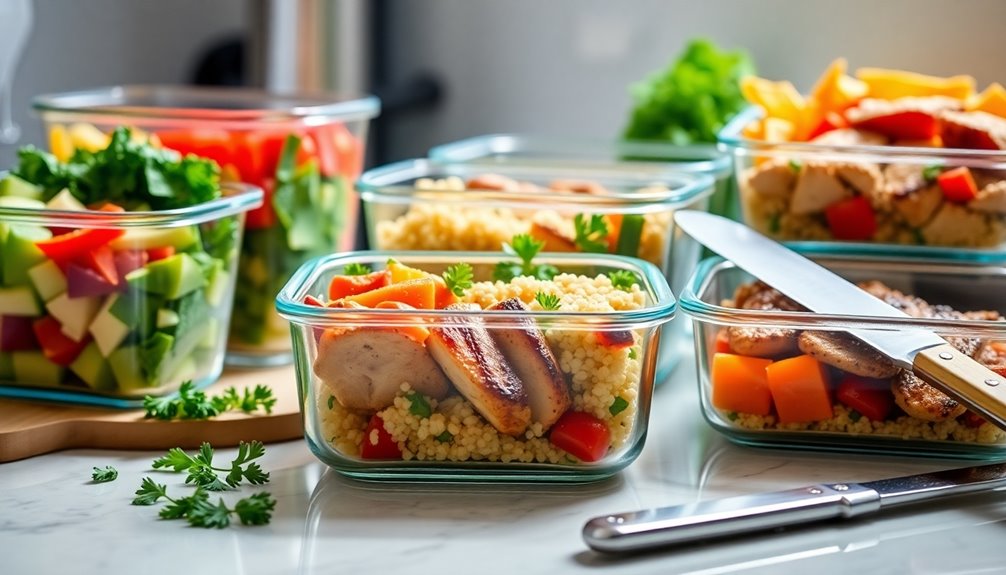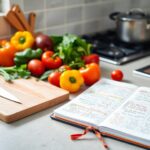To meal prep like a pro for weight loss, start by planning your weekly menu with balanced meals using lean proteins, whole grains, and plenty of veggies. Invest in quality containers to control portions and keep your meals fresh. Dedicate a day for batch cooking, whipping up versatile dishes like stir-fries or quinoa bowls. Use a food scale to measure servings and guarantee you're mindful of portions. Label your containers for easy tracking and storage. Consistency is key—set realistic goals and celebrate your progress. Keep exploring strategies to stay on track and make meal prepping a seamless part of your routine.
Key Takeaways
- Plan and prepare meals in advance to save time and avoid unhealthy food choices, promoting adherence to a healthy eating pattern.
- Choose lean proteins, whole grains, and plenty of vegetables for balanced meals that support weight loss goals.
- Use quality containers for portion control, ensuring proper food storage to maintain freshness and prevent spoilage.
- Dedicate a specific day for batch cooking, making it easier to have healthy options readily available throughout the week.
- Track your progress and celebrate milestones to maintain motivation and consistency in your weight loss journey.
Benefits of Meal Prepping
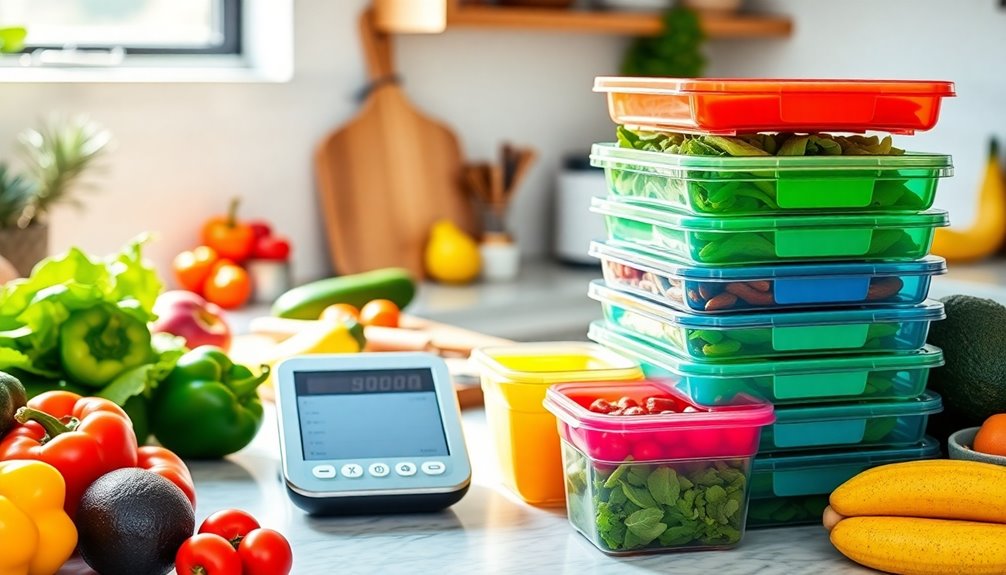
Why should you consider meal prepping for weight loss? Meal prepping isn't just a trend; it's a practical strategy that can lead to significant benefits in your weight loss journey.
First off, it's a major time-saver. By dedicating a few hours each week to plan and prepare your meals, you eliminate the daily scramble of figuring out what to eat. This means you can enjoy nutritious meals without the last-minute stress of cooking, which often leads to unhealthy choices.
Moreover, meal prepping is stress-reducing. When you have pre-portioned meals ready to go, you're less likely to reach for takeout or processed snacks when hunger strikes. This structured approach keeps you on track with your dietary goals and fosters a sense of control over your eating habits. Studies suggest that people who plan their meals are more successful at adhering to healthy eating patterns, which can ultimately lead to sustainable weight loss.
Additionally, meal prepping helps you make better food choices. When you take the time to plan, you're more likely to incorporate a variety of whole foods, ensuring you get the nutrients you need. You'll also save money by buying in bulk and reducing food waste. Incorporating the Keto diet into your meal prep can further enhance your efforts by promoting rapid and healthy fat loss.
In short, meal prepping isn't just about losing weight; it's about creating a healthier lifestyle. By saving time and reducing stress, you pave the way for a more fulfilling and successful journey towards your weight loss goals.
Essential Meal Prep Tools
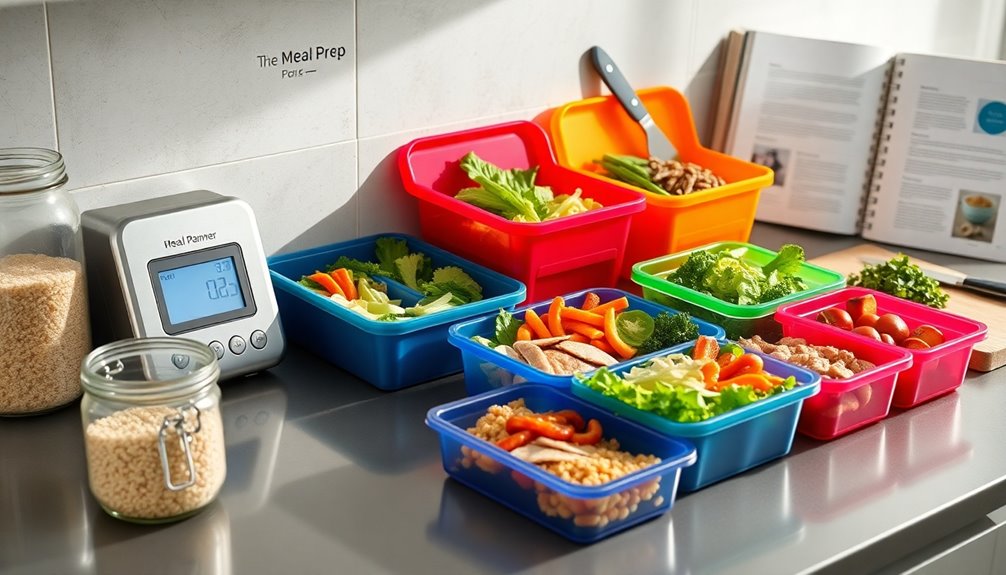
What tools do you need to make meal prepping efficient and effective? To kickstart your meal prep journey, invest in a few must-have gadgets that will streamline the process and help you stay on track with your weight loss goals.
First, a quality set of containers is vital. Opt for glass or BPA-free plastic containers with compartments for portion control. These are excellent for storing prepped meals, and they're microwave-safe for quick reheating. Consider containers with airtight lids to preserve your meals longer.
Next, a good knife and cutting board are essential. A sharp knife not only speeds up your chopping but also ensures safety in the kitchen. Pair this with a sturdy cutting board to create a reliable workspace.
You'll also want to grab a food scale. Weighing your portions can help you better understand serving sizes and make more informed decisions about your meals, which is a key time-saving tip when it comes to calorie counting. Remember, understanding the energy stored in food is crucial for effective weight loss.
Lastly, a slow cooker or Instant Pot can be your closest companion. These appliances allow you to prepare large batches of food with minimal effort, letting you set it and forget it while you tackle other tasks.
Planning Your Weekly Menu
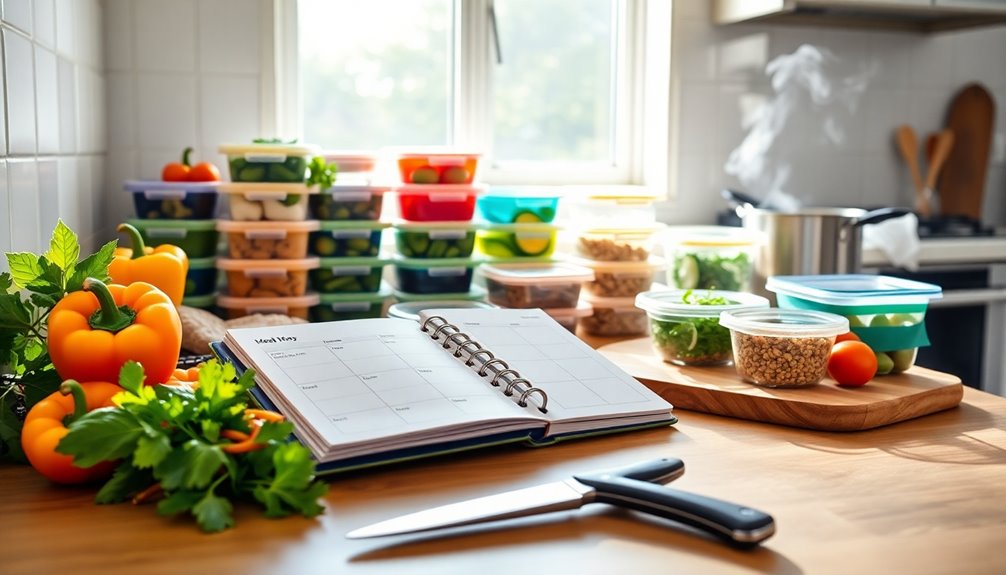
Planning your weekly menu is a game changer when it comes to staying on track with your weight loss goals. By mapping out your meals in advance, you not only enhance your time management skills but also streamline your grocery shopping, making budget planning a breeze. A well-structured menu helps you avoid impulse buys and guarantees you stick to your nutritional needs.
To get started, create a simple table to organize your meals. Here's an example to guide you:
| Day | Breakfast | Dinner |
|---|---|---|
| Monday | Overnight oats | Grilled chicken |
| Tuesday | Smoothie bowl | Quinoa salad |
| Wednesday | Greek yogurt | Stir-fried veggies |
| Thursday | Scrambled eggs | Baked salmon |
This table helps you visualize your week at a glance. You can adjust the meals based on your preferences and what's in season, which can assist in budget planning. Moreover, consider batch-cooking some components—like grains or proteins—so you can mix and match throughout the week. This not only saves time but also keeps your meals exciting and varied. Additionally, incorporating plant-based foods into your meal prep can enhance your overall health and support your weight loss journey.
Choosing Healthy Ingredients
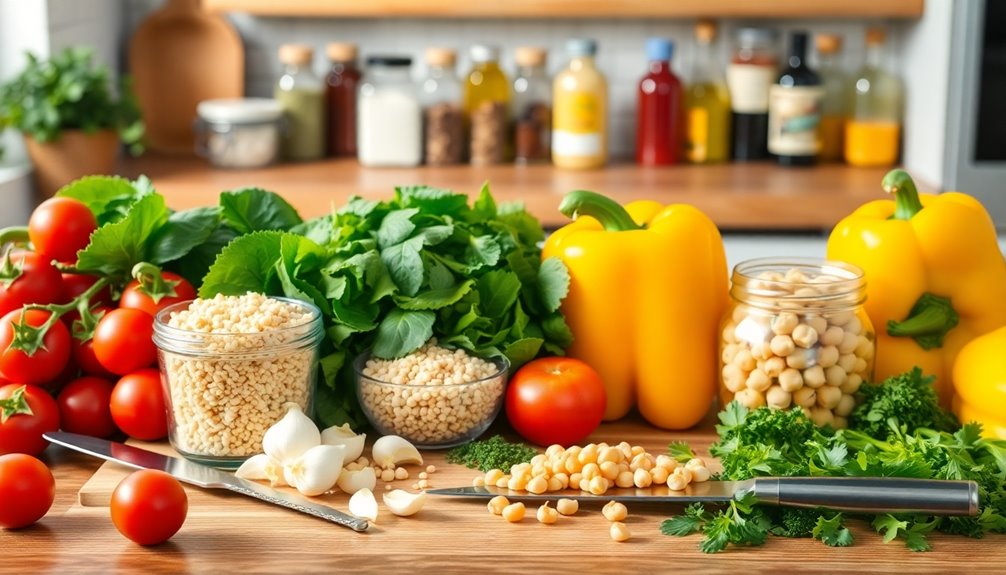
Choosing healthy ingredients is essential for successful meal prep, especially when you're aiming for weight loss. By selecting nutrient-dense options, you not only nourish your body but also set yourself up for success during the week. Start by focusing on whole foods and consider making simple ingredient swaps and recipe modifications that can make a big difference.
Here are some tips to guide you:
- Opt for lean proteins: Choose chicken breast, turkey, or plant-based proteins like beans and lentils to keep meals satisfying.
- Load up on veggies: Incorporate a variety of colorful vegetables, as they're low in calories and high in fiber, helping you feel full longer.
- Choose whole grains: Swap refined grains for whole grains like quinoa, brown rice, or whole wheat pasta for added nutrients and fiber.
- Limit added sugars: Use natural sweeteners like honey or maple syrup sparingly, or experiment with spices like cinnamon to enhance flavor without extra calories.
- Mind your fats: Choose healthy fats from sources like avocados, nuts, and olive oil while being mindful of portion sizes.
Additionally, incorporating healthy recipes into your meal prep can provide you with new ideas and keep your meals exciting throughout the week.
Batch Cooking Techniques
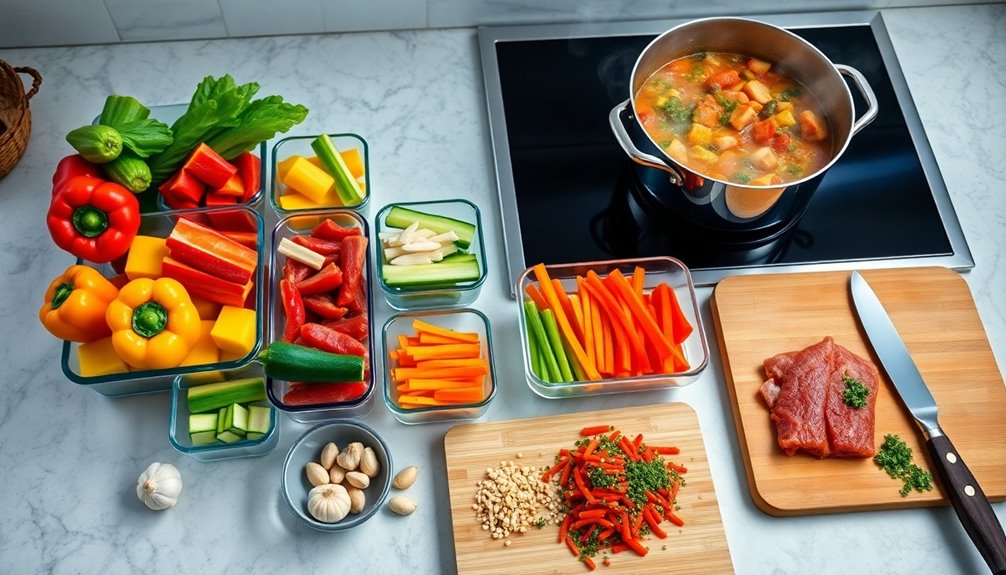
Batch cooking is a powerful strategy that can streamline your meal prep and support your weight loss goals. By dedicating a few hours each week to cook large portions of meals, you can save time and make sure you've got healthy options ready, eliminating the temptation to reach for less nutritious choices. Start by selecting a day to batch cook, and stick to it.
Use time-saving hacks like prepping ingredients in advance. Chop vegetables or marinate proteins the night before. When you're ready to cook, everything's at your fingertips. Consider versatile flavor combinations that can be used across various meals. For instance, roasted sweet potatoes, quinoa, and grilled chicken can be seasoned differently throughout the week—think Mediterranean herbs one night and spicy chili the next.
Make sure to cook a variety of grains and proteins. Cooked brown rice, lentils, or whole grain pasta are excellent bases, while chicken, turkey, or plant-based proteins can offer satisfying options.
Don't forget vegetables! Roasting a mix of seasonal veggies adds nutrition and flavor to any dish. Incorporating smoothie recipes into your meal prep can also provide a quick and nutritious option that complements your batch-cooked meals.
Lastly, try to create meals that can be easily transformed. A big batch of chili can serve as a filling lunch one day and turn into a taco filling the next. Embracing these batch cooking techniques not only supports your weight loss journey but also fosters a sense of community as you share your delicious creations with friends and family. You've got this!
Proper Food Storage Tips
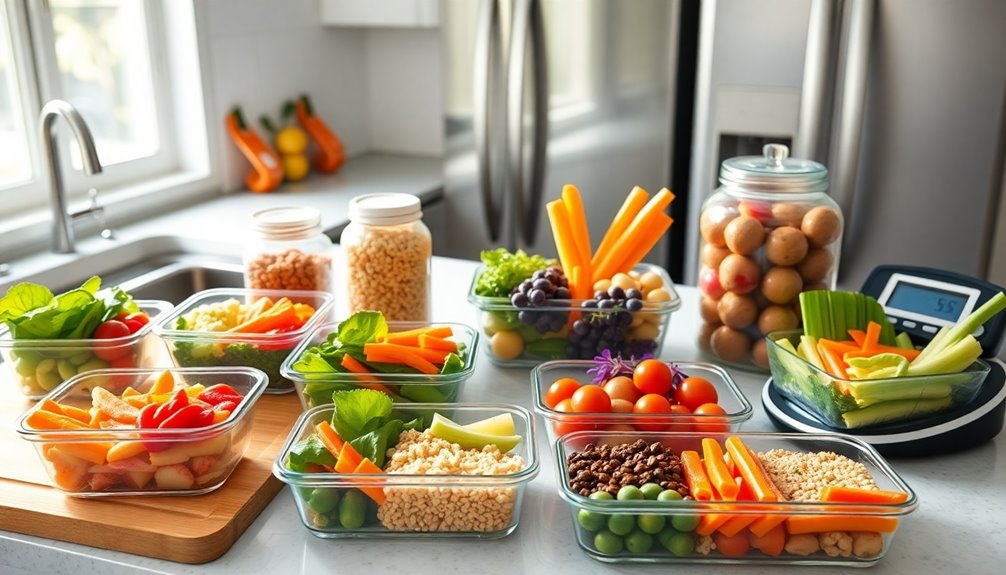
Proper food storage is vital for maintaining the quality and safety of your meal prep. It not only helps your meals last longer but also guarantees you're consuming safe, nutritious food each day. To achieve this, focus on effective refrigerator organization and follow these practical tips:
- Use airtight containers: They prevent moisture and odors from spoiling your meals.
- Label your containers: Include the date and contents to keep track of freshness.
- Store foods at the correct temperature: Keep your fridge at or below 40°F (4°C) to inhibit bacterial growth.
- Separate raw and cooked foods: Avoid cross-contamination by storing raw meats on the bottom shelf and cooked meals above.
- Utilize transparent containers: This allows you to see what's inside at a glance, making it easier to choose healthy options.
Practicing good food safety is essential, especially when you're committed to a weight loss journey. By organizing your refrigerator efficiently, you can minimize food waste and make healthier choices more accessible. Always remember to check expiration dates and consume older items first. Additionally, embracing a structured meal plan can enhance your metabolism and further support your weight loss efforts through promoting weight loss.
When you take the time to properly store your meals, you're not just protecting your hard work; you're also nurturing a sense of accountability to yourself and your health goals. So, invest in some quality storage solutions and make food safety a priority in your meal prep routine. Your future self will thank you!
Portion Control Strategies
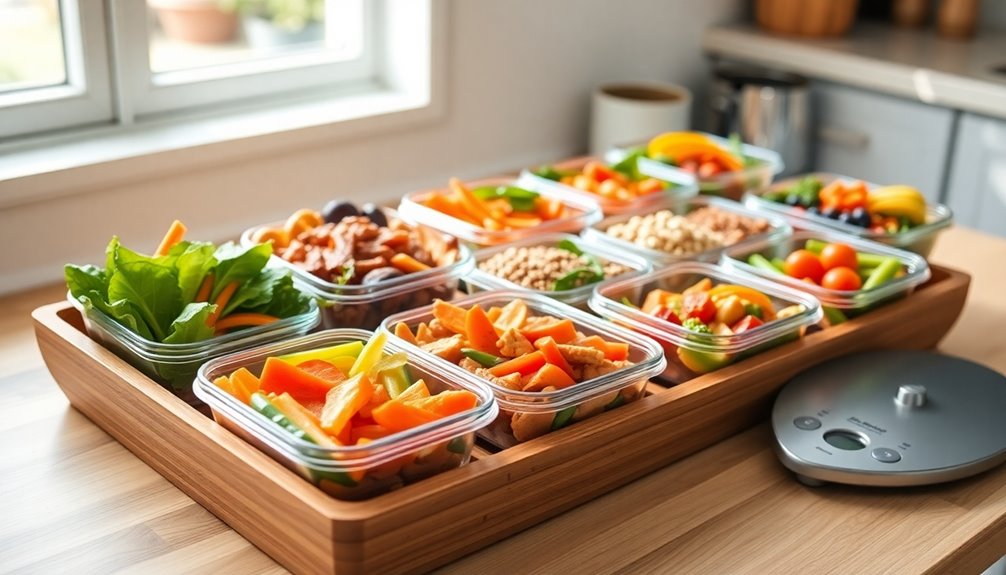
Many people find that mastering portion control is crucial for successful weight loss. It's not just about what you eat, but how much you consume. One effective strategy is to practice mindful eating. This means being fully present during meals, focusing on the flavors, textures, and aromas of your food. By slowing down and appreciating each bite, you're more likely to recognize when you're satisfied, preventing overeating.
To help with portion control, try using smaller plates and bowls. This simple change can make a significant impact on how much food you serve yourself. When your plate looks full, you'll feel more satisfied, even if the portion size is smaller.
Additionally, measuring your food can be advantageous. Use measuring cups or a food scale to understand serving sizes better. This practice not only helps you stick to balanced meals but also teaches you what appropriate portions look like.
Another helpful tactic is to divide your plate into sections: fill half with vegetables, a quarter with lean protein, and a quarter with whole grains. This guarantees that your meals are balanced and nutrient-rich while keeping portions in check. Remember to listen to your body's hunger cues; eat when you're hungry, and stop when you're content. Incorporating tools like mini bands can enhance your fitness routine, which in turn supports your weight loss journey by providing effective muscle toning and improved movement.
Quick Meal Prep Recipes
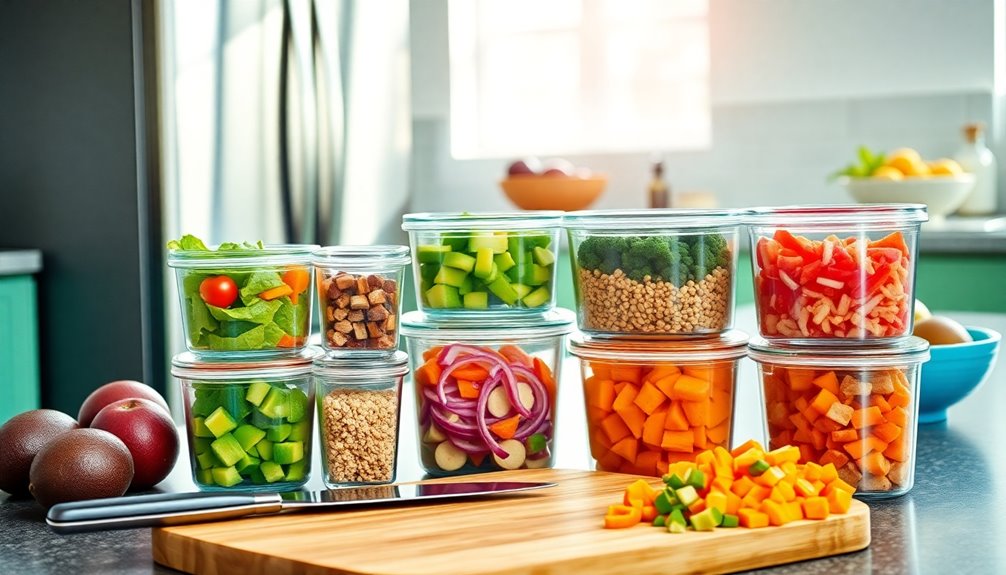
Meal prepping can be a game-changer when it comes to maintaining a healthy diet while losing weight. By dedicating just a little time each week to prepare meals, you can save time during your busy days and stay on track with your goals. Here are some quick meal prep recipes that aren't only nutritious but also budget-friendly options.
- Overnight oats: Mix rolled oats with your favorite milk and toppings like fruits or nuts. Let it sit overnight for a quick breakfast.
- Mason jar salads: Layer your favorite veggies, protein, and dressing in a jar. Shake it up for a fresh lunch anytime.
- Stir-fried veggies and protein: Toss together a mix of seasonal veggies with chicken or tofu in a pan. This comes together in just 20 minutes!
- Quinoa bowls: Cook a batch of quinoa and top it with black beans, corn, and salsa for a filling meal.
- Soup or chili: Make a big batch and freeze portions. It's a warm, comforting meal that you can easily reheat.
Incorporating homemade vegan smoothies into your meal prep can further enhance your nutritional intake and help you stay energized throughout the day. Utilizing these recipes not only provides you with delicious meals but also incorporates time-saving tips that fit your busy lifestyle. You can stick to your budget while enjoying nutritious food.
Staying Motivated and Consistent
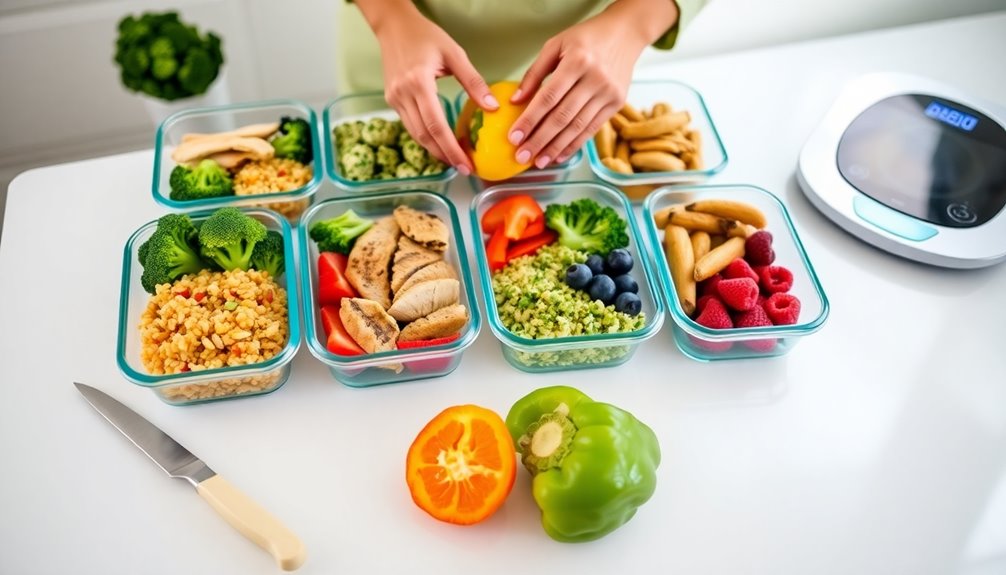
Staying motivated and determined on your weight loss journey can feel like climbing a steep mountain, but you can reach the summit with the right strategies. Start by setting realistic goals that align with your lifestyle. Break them down into smaller, achievable milestones. This way, you'll experience a sense of accomplishment frequently, which fuels your motivation.
Accountability plays a vital role in maintaining your commitment. Share your goals with a friend, family member, or join a supportive group. Having someone to check in with can make a significant difference. You're not alone in this journey, and sharing your experiences creates a sense of belonging.
Tracking your progress is another essential component. Use a journal or an app to log your meals, workouts, and achievements. Seeing how far you've come can be incredibly motivating and helps you identify patterns or areas for improvement.
Don't forget to celebrate your successes, no matter how small. Rewards can be a powerful motivator. Treat yourself to something enjoyable—maybe a new workout outfit or a relaxing day off. These rewards reinforce positive behavior and keep you engaged in your weight loss journey.
Lastly, remember that consistency is key. It's about making sustainable choices rather than aiming for perfection. Embrace the ups and downs; it's all part of the process. With your goals in sight, accountability in place, and a system for tracking progress, you'll find the motivation to keep climbing that mountain. Additionally, understanding how to reverse Type 2 diabetes naturally can enhance your overall health and support your weight loss efforts.
Frequently Asked Questions
How Do I Handle Leftovers When Meal Prepping?
When handling leftovers, you can use effective reheating strategies to maintain flavor and texture. Consider storing meals in individual portions to help with portion control, making it easier to grab and go.
Use airtight containers to keep food fresh, and label them with dates for tracking. Reheat dishes evenly in the microwave or oven, stirring occasionally to avoid cold spots.
This way, you'll enjoy your meals while minimizing waste and maximizing convenience.
Can I Freeze All Meal Prep Dishes?
Freezing meal prep dishes is like putting food in a time capsule; it preserves flavors and nutrition for later enjoyment. However, consider freezing options carefully. Some ingredients, like leafy greens, may lose texture and flavor.
Longevity concerns also arise—most meals last up to three months in the freezer. To maximize quality, label your containers with dates and usage instructions.
With thoughtful choices, you can enjoy your meals whenever you want, fostering a sense of belonging in your food journey.
What Are the Best Containers for Meal Prepping?
When choosing the best containers for meal prepping, focus on portion control and container sizes. Opt for BPA-free plastic or glass containers, as they're durable and microwave-safe. Look for various sizes to accommodate different meals—like larger ones for salads and smaller ones for snacks.
Using clear containers helps you see your meals at a glance, making it easier to stick to your plan and feel organized in your meal prep journey.
How Do I Avoid Meal Prep Burnout?
To avoid meal prep burnout, focus on variety and creativity. Experiment with new recipes or cuisines to keep things exciting, which helps in avoiding boredom. Make a list of go-to meals and rotate them weekly to maintain interest.
Staying motivated is key, so consider prepping with a friend or sharing your meals online for a sense of community.
Is It Okay to Meal Prep for Multiple Weeks?
Yes, you can meal prep for multiple weeks, but keep freshness concerns in mind. It's vital to store meals properly to maintain their quality. Consider freezing some dishes to extend their lifespan.
Also, focus on nutritional balance; include a variety of proteins, grains, and veggies to guarantee you get the nutrients you need. By planning ahead, you'll not only save time but also create a sense of belonging in your meal prep routine.
Conclusion
By embracing meal prep, you're not just saving time; you're setting yourself up for weight loss success. With the right tools, a solid plan, and healthy ingredients, you'll be cooking up a storm in no time. Remember, consistency is key—stick to your routine, and you'll see results. So, get your ducks in a row, and make meal prepping a part of your lifestyle. You'll find it's a game changer on your journey to better health.

